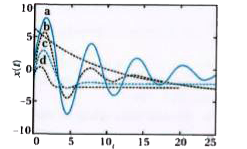Derive differenital equation for damping oscillations and writes its solution.Solution in Gujrati
The resistive force acting on the oscillator in a fluid medium depends upon the velocity of the oscillator.
In practice, for not very large velocities, the resistive force is directly proportional to the velocity of the oscillator.
Resistive force Fd∝−v
∴Fd=−bv ..........(1)
Where b is positive constant and it is called damping coefficient.
It depeds on characteristics of medium (like viscosity) and the size and shape of the block.
The unit of damping coefficient (b=Fdv) is NSm and dimensional formula is [M1L0T−1].
When the oscillator has displacement x from mean position, the restoring force (FS) produced in it is FS=−kx .......(2)
Thus, the total force acting on the mass at any time t is,
F=FS+Fd
∴F=−kx−bv .........(3)
If a(t) is the acceleration of mass at time t, then by Newton.s law of motion, F=ma(t)
From equation (3)
ma(t)=−kx(t)−bv(t) ..........(4)
but a(t)=d2xk(t)dt2 and v(t)=dx(t)dt
∴md2x(t)dt2+bdx(t)dt+kx=0 ........(5)
is the differential equation for damping oscillations.
The solution of equation (5) is below (without proof)
x(t)=Ae−bt2mcos[ω.t+ϕ] ........(6)
where Ae−bt2m is the amplitude of oscillator and ω. is the angular frequency of oscillator and it is obtained from the formula ω.=√km−b24m2
In this function, the cosine function has a period 2πω. but function x(t) is not pure periodic because of the factore e−bt2m which decreases continuously with time. If the decrease is small in one time period T, the equation (6) is approximately periodic.
The solution of equation (5) can be graphically represented as shown in figure.

Equation (6) is considered as consine function whose amplitude (Ae−bt2m), which is gradually decrease with time.
In the graph a damped oscillator is periodic with decreasing amplitude of oscillation with greater damping oscillation die out faster.
Topper's Solved these Questions
- OSCILLATIONSBook:KUMAR PRAKASHANChapter:OSCILLATIONSExercise:SECTION-A (TRY YOURSELF)
Explore 64 Videos
- OSCILLATIONSBook:KUMAR PRAKASHANChapter:OSCILLATIONSExercise:SECTION-B (NUMERICAL FROM TEXTUAL ILLUSTRATIONS)
Explore 40 Videos
- OBJECTIVE QUESTIONS AS PER NEW PAPER STYLE Book:KUMAR PRAKASHANChapter:OBJECTIVE QUESTIONS AS PER NEW PAPER STYLE Exercise:CHAPTER - 8 (Match Type questions)
Explore 5 Videos
- PHYSICAL WORLDBook:KUMAR PRAKASHANChapter:PHYSICAL WORLDExercise:SECTION-E (QUESTIONS FROM MODULE)
Explore 9 Videos
Similar Questions
What is motion ?
View SolutionOn an average, a human heart is found to beat 75 times in a minute. Calculate its frequency and period.
View SolutionType of satellites are given in Column-I and their uses are given in Column-II. Match them properly :
Column-IColumn-II(1) Polar satellite(a) Tele communication(2) Geo-stationary satellite(b) Investigation(c) For information about atmosphere
View Solution.…. state of substance at very high temperature has generated hope of energy source for mankind.
View SolutionIn case of damped oscillation frequency of oscillation is
View SolutionThe differenital equation of all circles whose centres are at the origin is
View SolutionWhich of the following equation represents damped oscillation?
View SolutionWrite the expression of mechanical energy of damped oscillator.
View SolutionWrite the equation of angular frequency for damped oscillation.
View SolutionWrite the equation of amplitude for damped oscillations.
View SolutionIf damped oscillator is very heavy then what is its frequency?
View SolutionA oscillator of mass 100g executes damped oscillation. When it complete 100 oscillations its amplitude of oscillation becomes half to its original amplitude. If time period is 2s, then find the value of damping coefficient.
View SolutionA oscillator of mass 100g executes damped oscillation. When it complete 100 oscillations its amplitude of oscillation becomes half to its original amplitude. If time period is 2s, then find the value of damping coefficient.
View SolutionDerive a differential equation for a damped harmonic oscillation.
View SolutionThe amplitude of oscillation of a harmonic oscillator oscillating in air decreases continuously. This is because of damping. If the damping force is proportional to the velocity of the oscillator, give the expression for its frequency.
View Solution